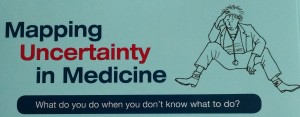The practice of medicine gets more complicated every year,and it feels like everyone expects clinicians to “know what to do”and have all the answers. So what happens if a clinician is not sure what to do next? We call this the “What do you do when you don’t know what to do” moment or WDYDWYDKWTD for short.
Marshal Marinker famously commented that the role of the Primary Care physician (or family physician) is “to tolerate uncertainty, explore probability and marginalise danger, whereas hospital specialists have to reduce uncertainty, explore possibility and marginalise error”(1) . Yet for most clinicians “tolerating uncertainty” is extremely uncomfortable. It makes us ask ourselves “am I about to make a terrible error?” or wonder if we are going to be criticised or sued. The result is that most clinicians try to minimise uncertainty because it feels so uncomfortable.
And yet, uncertainty does not go away and we all face uncertain situations everyday. Simply tolerating this does not feel like a satisfactory way forwards. But help is at hand from our book “Mapping Uncertainty in Medicine”. In the book we explore ways to understand uncertainty in clinical practice, to classify it into different types, and to identify which skills can be used to manage uncertainty in different types of situations, using a process called Mapping Uncertainty in Medicine or MUM for short. Its always good to have your MUM with you in a tricky situation!
(1) Marinker M and Peckham PJ (eds). Clinical Futures London: BMJ Books, 1998
